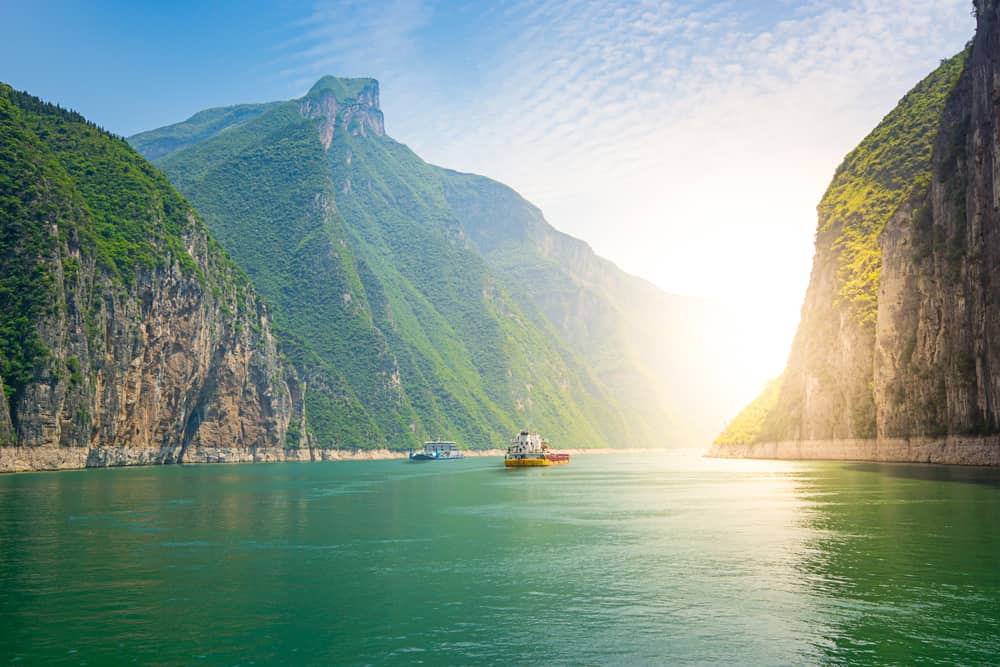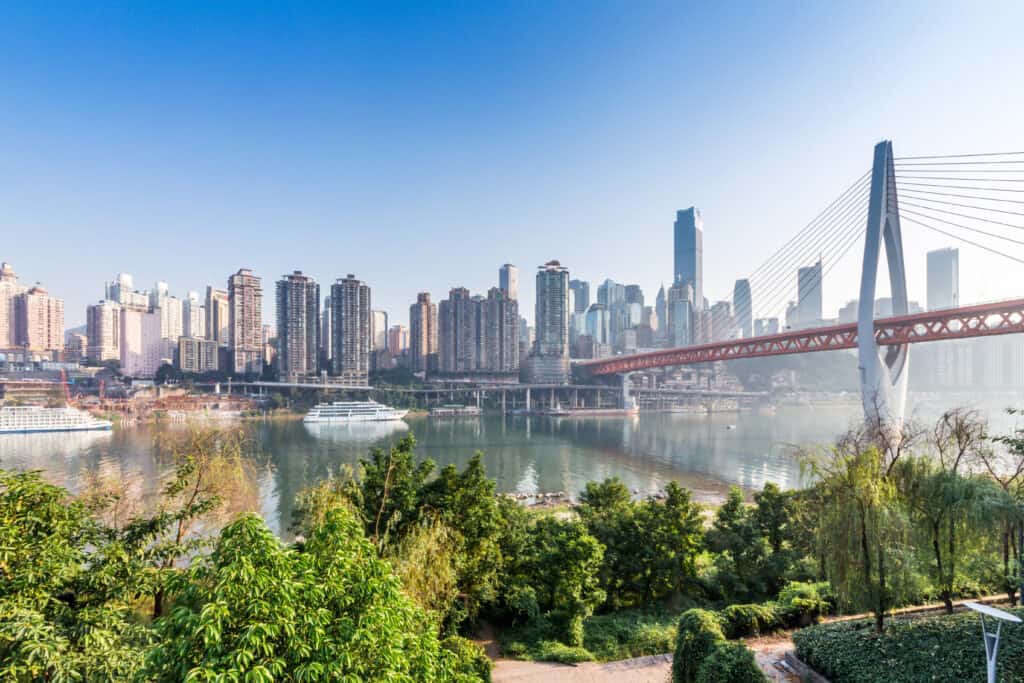The Yangtze River is one of the most famous rivers in the world. Its water has been fundamental in the rise and fall of empires and whole civilizations. Today it is a rushing source of pride and culture for China and its people. Modern society and technology, however, threaten to destroy this hallmark of Earth’s natural beauty forever. You might have seen news stories or headlines about the pollution in the Yangtze, but how polluted is it really? What is causing the pollution? Can the problem be fixed?
Background on The Yangtze River

The Yangtze River is an essential shipping corridor.
©Daniel Doerfler/Shutterstock.com
Yangtze literally means “long river”. It is the longest river in all of Eurasia, and the third-longest in the entire world. The Yangtze is the longest river in the world that starts and ends in just one country: China. It is the fifth-largest river in the world by water volume. Its drainage basin covers over 20% of all of China.
The Yangtze has been the lifeblood, border, and cultural centerpiece for societies for thousands of years. This majestic river continues to influence the growth of the Chinese cities that sit along its banks. Today, almost 33% of all the people in China live by the Yangtze. You can even find the largest hydroelectric dam in the world, the Three Gorges Dam along this incredible river. The Yangtze River Delta alone accounts for 20% of China’s GDP.
Parts of the river are protected as nature reserves. One section is even a UNESCO World Heritage Site known as the Three Parallel Rivers of Yunnan.
How Polluted is China’s Yangtze River?

Giant algae blooms cause by pollution in the Yangtze kill uncountable amounts of fish every year.
©O partime photo/Shutterstock.com
In recent years, due to lax regulations and population growth, pollution has ravaged the Yangtze River. Industrial waste, plastic pollution, agriculture waste, destruction of wetlands and lakes, and general garbage and human waste have all contributed to the destruction of this river. The Yangtze contributes more pollution to the ocean than any other river in the world.
Environmental destruction
China began building dams and dikes along the Yangtze in the 1950s. These dams cut off hundreds of lakes from the river. They had planned to use gates to allow water to flow between the river and these lakes, but unofficial settlements cropped up along the rivers and lakes making it dangerous and expensive to open these gates. As a result, many of the lakes dried up and local habitats were permanently destroyed. This upheaval of the water flow between the Yangtze and the river exacerbates any pollution that enters the river today. Numerous species began to decline as a result and several have gone extinct including the baiji dolphin. Other species of porpoise, alligator, and fish are at immediate risk of extinction from the disruption of water flow alone.
Pollution status today
In 2016 over 35 billion tons of waste water flowed into the Yangtze River. The people in China used to say that you could cross the Yangtze by walking on the garbage without getting wet. All along the river, factories used to dump their waste and sewage directly into the river without regulation. Unregulated farming and agriculture also dumped thousands of tons of fertilizer and waste into the water.
It is impossible to know exactly how much garbage has entered the river over the years because so many people live in small towns and villages that do not officially exist. The pollution got so bad that international organizations finally noticed and China started to make efforts to protect the river and its water. However, cleaning the river after decades of pollution is no easy feat. There is momentum to cultural trends. Millions of tons of garbage still pour into the river each year despite the government’s efforts.
Nitrogen and phosphorus from agriculture along the river have made whatever clean water still available almost unusable. These two are primary ingredients in fertilizer which is dumped into the river or finds its way there after heavy rain. Nitrogen and phosphorus cause eutrophication in lake water, which supercharges the growth of algae. This causes giant algae blooms that destroy local plant life, suffocate water plants and animals, and make the water unfit for other uses.
The Yangtze is huge. It is an important route for transportation and commerce. Thousands of ships use it every day. These ships often dump their garbage and waste directly into the river. At its peak in 2015, ships dumped over 750,000 tons of garbage into the water and released 360 million tons of living sewage.
What Will Happen to The Yangtze River?

Skyline of Chongqing which sits along the Yangtze River.
©MyCreative/Shutterstock.com
It is hard to overstate the importance of cleaning and preserving the Yangtze. Not only does it contribute to the water stability of the ocean near and around China and South Eastern Asia, but it also supports and creates unique biomes and species that can’t be found anywhere else on Earth. That’s not to mention the millions of people who live along its banks and rely on it for their survival.
Experts say that if we don’t do something to reverse the damage of pollution and global warming, the destruction of the Yangtze River will continue. Beyond the extinction of species, famine, disease, and other ecological disasters, a number of untold and unpredictable consequences will follow the loss of the Yangtze River.
However, many people are trying to not only clean the river but also prevent future pollution. The World Bank approved a US$200 million loan in 2023 to help protect the river and reduce pollution in just the Hubei Province in China. While this won’t fix the problem, it is a sign that international organizations are taking the problem seriously. The Chinese government also created new positions called “river chiefs”. Their sole purpose is to manage the pollution of the river in their district. The Chinese government has begun to make concerted efforts to protect the remaining wildlife and ecosystems, reduce water pollution, remove plastic and garbage from the water, and regulate wastewater.
Why is Cleanup Taking So Long?

Pollution like oil and others chemicals can take decades to clean up.
©Denise Hasse/iStock via Getty Images
The Yangtze River has been polluted for a long time. The people who live there are often impoverished and uneducated. These people don’t have the luxury of disposing of their waste and garbage when they are trying to help their families survive. It will take years of education, investment in new waste infrastructure, and social change to affect the trajectory of society along the Yangtze River. Yet, with enough time and money, experts are hopeful that we can save the river, the animals who live there, and the people who rely on it.
The photo featured at the top of this post is © martinho Smart/Shutterstock.com
Thank you for reading! Have some feedback for us? Contact the AZ Animals editorial team.







